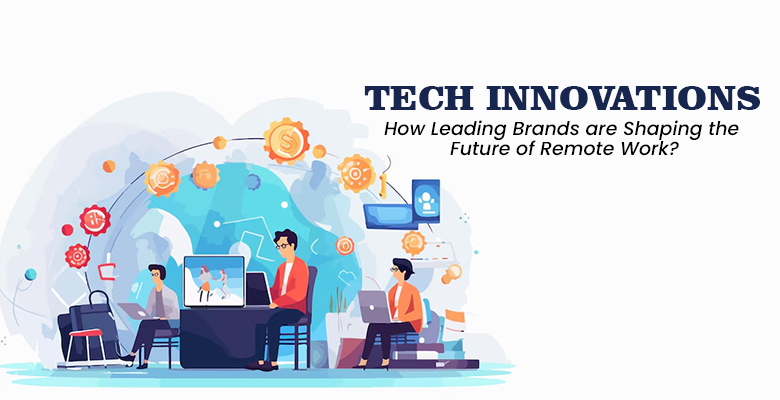
Remote work completely changed the nature of collaboration, communication, and work itself. Leading tech companies have been at the forefront of making seamless, secure, and productive remote work possible. As work-from-home continues to evolve, tracking the role top brands play in its future is crucial. From cutting-edge collaboration tools to cybersecurity innovations, these companies are redefining the workplace. Read below to learn about the future of remote work and how brands are shaping it.
Microsoft

Undoubtedly, Microsoft has been a leader in providing tools that support remote work. Microsoft Teams, the company’s flagship collaboration platform, saw exponential growth during the pandemic, reaching over 280 million active users as of early 2024. The company is shaping the future of remote work for sure. Microsoft’s vision for hybrid work includes
- Collaborative Features- Real-time file sharing, video conferencing, and integrated chat functions.
- Azure and Cloud Solutions- With the usage of cloud computing and data storage in most businesses, such types of applications are implemented to ensure that any information is accessible from anywhere with adequate security degrees.
Recent Data
- 68% of the big organizations globally use Microsoft Teams to collaborate and communicate with internal and external employees.
- Revenues from the clouds for Microsoft increased by 35% in the last quarter of 2023 and continue with Cloud-based solutions for remote work.
Zoom

Zoom became a household name during the early days of the pandemic and is one of the most important tools for remote work. From global meetings to webinars, Zoom is at the core of how organizations communicate.
- Zoom Rooms- Hardware solutions for businesses to create collaborative spaces where the physical and virtual participants can be efficiently mixed.
- AI Features- Innovations by Zoom, in line with AI features, include automatic transcription, language translation, and also AI-based meeting summaries that help make virtual meetings easier.
Recent Data
- By the end of 2023, Zoom was hosting over 3.3 trillion annual meeting minutes.
- The firm raked in 20% more revenue because hybrid work models became the new norm across all industries.
Google Workspace

At the core of this remote working has been Google Workspace, which offers a bouquet of cloud-based applications including Gmail, Google Docs, Sheets, Meet, and Drive. It’s been highly useful in making sure collaboration does happen in real-time across teams and geographies.
- Smart Canvas- Launched in 2022, Smart Canvas allows its users to craft engaging documents that can easily link to other Google Workspace resources, boosting productivity.
- Greater Security- The company is also associated with zero-trust principles and advanced threat protection to enhance its cybersecurity capabilities.
Recent Data
- By December 2023, Google Meet had exceeded more than 100 million users per day.
- By 2023, Google Workspace gained over 3 million business customers, showing the trend toward cloud-based collaboration.
Slack

Owned by Salesforce, Slack has emerged with one of the highest recognition scores of any messaging app for remote teams. Over 2,400 other tools are integrated within its platform to streamline workflows; routine tasks are automated, and multiple functions get merged into a single interface.
- Slack Connect- Different organizations can collaborate in a secure, shared workspace with this feature.
- Workflow Builder- This enables people to automate tasks so that productivity levels won’t drop in remote environments.
Recent Data
- As of the middle of 2023, the company Slack had more than 12 million active users daily
- An increase of up to 30% in overall productivity is seen among companies using Slack.
Apple

Through macOS and other products like iCloud and collaboration tools, Apple has stepped into the arena as a facilitator of work-in-progress remote features. With its powerful ecosystem in iPhone, iPad, and Mac, Apple provides users with seamless integration and presence in workspaces.
- FaceTime and SharePlay- Using SharePlay, the remote teams can share the screen for document review, to scrutinize a presentation live in case of a FaceTime call.
- iCloud- With an Apple cloud solution, the storage is safe and easy as well as reliable for storing and peer-to-peer collaboration from the iWork application to the Notes program.
Recent Data
- 80% of Fortune 500 companies had adopted Apple products by the end of 2023.
- iCloud business subscriptions increased by 15% as more companies shifted to the use of cloud-based document management.
Dell and HP


When it comes to the hardware, the remote work revolution has been driven by quite a few software solutions. Dell and HP have developed several products for the remote work environment.
- Dell’s Latitude Laptops- They offer a specific focus on remote professionals with their extended battery life. Apart from that they offer best-in-class sound quality from their high-end webcams, and AI-based noise cancellation.
- HP’s ZBook Series- They manage the description by optimizing the working machines required for remote creatives and engineers. They use high-performance data-intensive tasks.
Recent Data
- Dell reports a 25% jump in sales of hardware for remote work in 2023.
- HP commercial laptops also witnessed a 30% growth, which shows a continuation in the requirement for remote work hardware.
Our Last Words
Going forward into the future of remote work, innovations from these tech companies will continue to redefine the approach towards distance working. Leverage cloud computing, AI-driven collaboration tools, virtual reality, and heightened security measures to ensure productivity and efficiency in remote working. This means hybrid work is the new normal. Companies like Microsoft, Zoom, and Google are set to drive not only today’s remote workforce but pave the way for generations of workers yet to come.
